
|
Bright new comet discovered in the SWAN images. Now it is 7.8 mag (Apr. 8, Osamu Miyazaki). It brightens up to 4 mag, but it will turn to fade out rapidly after that. In the Northern Hemisphere, it will be unobservable soon. In the Southern Hemisphere, it is not observable now, but it will appear in May.
Date(TT) R.A. (2000) Decl. Delta r Elong. m1 Best Time(A, h)
Apr. 5 23 22.93 23 59.8 1.484 0.773 28 9.2 4:15 (248, 11)
Apr. 12 0 0.24 29 6.4 1.298 0.626 28 7.5 4:04 (241, 10)
|

|
It is visible at 11 mag in the SWAN images (Jan. 27, Vladimir Bezugly). It will fade out rapidly after this. Now it is not observable. It will appear in July in the Southern Hemisphere.
Date(TT) R.A. (2000) Decl. Delta r Elong. m1 Best Time(A, h)
Apr. 5 1 8.81 5 27.9 2.018 1.021 3 10.8 19:50 (109,-16)
Apr. 12 1 38.77 5 58.4 2.035 1.040 5 11.0 19:57 (110,-16)
|

|
It approached to Sun down to 0.09 a.u. on Jan. 13. It brightened up to -2 or -3 mag and it was detected even in the daylight. The nucleus was disintegrated on Jan. 19. However, its remnant is still visible. Fading rapidly. In the Northern Hemisphere, it will never be observable after this. In the Southern Hemisphere, it will be getting higher gradually.
Date(TT) R.A. (2000) Decl. Delta r Elong. m1 Best Time(A, h)
Apr. 5 0 59.65 -43 49.4 2.473 1.980 49 11.9 19:50 ( 59,-41)
Apr. 12 1 12.62 -44 41.1 2.536 2.096 53 12.2 4:04 (301,-42)
|

|
It brightened up to -3 mag due to the forward scattering on Oct. 9 in the SOHO coronagraph images (Q.-c. Zhang, Charles S. Morris). It became a great comet of 0 mag on the ground. Now it is 12.4 mag (Mar. 22, Ken-ichi Kadota). Fading slowly. In the Northern Hemisphere, it stays observable in good condition. It locates somewhat low in the Southern Hemisphere.
Date(TT) R.A. (2000) Decl. Delta r Elong. m1 Best Time(A, h)
Apr. 5 20 25.31 19 19.7 3.541 3.280 66 12.6 4:15 (276, 44)
Apr. 12 20 23.73 20 35.1 3.532 3.368 72 12.7 4:04 (278, 48)
|
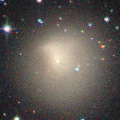
|
Now it is 10.9 mag (Mar. 21, Thomas Lehmann). In the Northern Hemisphere, it will be getting lower gradually after this, and it will be unobservable in July. In the Southern Hemisphere, it stays observable in good condition.
Date(TT) R.A. (2000) Decl. Delta r Elong. m1 Best Time(A, h)
Apr. 5 9 37.18 10 46.7 5.607 6.270 127 13.7 20:42 ( 0, 66)
Apr. 12 9 36.25 10 50.1 5.700 6.272 120 13.8 20:13 ( 0, 66)
|

|
Now it is 13.8 mag (Mar. 28, Thomas Lehmann). It stays 14 mag for a while. It stays observable in good condition.
Date(TT) R.A. (2000) Decl. Delta r Elong. m1 Best Time(A, h)
Apr. 5 15 32.55 -11 23.7 4.417 5.232 140 13.9 2:40 ( 0, 43)
Apr. 12 15 30.75 -10 26.6 4.371 5.248 148 13.9 2:11 ( 0, 44)
|

|
Parent asteroid of Geminids meteor shower. Now it is 15.9 mag (Jan. 12, E. Prosperi, M. Jaeger). It will fade out rapidly after this. It will be fainter than 18 mag in June. Now it is not observable. It will appear in May in the Northern Hemisphere, or in June in the Southern Hemisphere.
Date(TT) R.A. (2000) Decl. Delta r Elong. m1 Best Time(A, h)
Apr. 5 0 8.68 7 0.2 1.262 0.348 11 14.0 4:15 (255, -8)
Apr. 12 0 31.78 12 4.3 1.464 0.533 12 14.9 4:04 (250, -6)
|

|
It brightens up to 13 mag in early summer. But the condition in this apparition is bad. Now it is 14.4 mag (Apr. 1, Hidetaka Sato). Brightening slowly. In the Northern Hemisphere, it is not observable now, but it will appear in July. It stays extremely low in the Southern Hemisphere. But it will become high in autumn.
Date(TT) R.A. (2000) Decl. Delta r Elong. m1 Best Time(A, h)
Apr. 5 23 20.54 -7 45.0 2.190 1.380 27 14.4 4:15 (275, -7)
Apr. 12 23 44.93 -5 51.3 2.142 1.343 28 14.1 4:04 (272, -7)
|

|
Now it is 13.6 mag (Mar. 19, Thomas Lehmann). Fading gradually. It will be unobservable in July.
Date(TT) R.A. (2000) Decl. Delta r Elong. m1 Best Time(A, h)
Apr. 5 3 55.00 13 4.5 1.959 1.433 44 14.3 19:50 ( 91, 22)
Apr. 12 4 16.93 15 17.1 1.983 1.432 43 14.2 19:57 ( 95, 21)
|
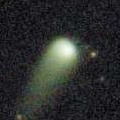
|
Now it is 14.1 mag (Mar. 9, Yoshiaki Yamaguchi). It stays 15 mag for a while. It locates somewhat low in the Northern Hemisphere. But it will become high in summer. In the Southern Hemisphere, it is not observable now.
Date(TT) R.A. (2000) Decl. Delta r Elong. m1 Best Time(A, h)
Apr. 5 1 35.52 47 55.6 4.763 4.087 42 14.3 19:50 (139, 15)
Apr. 12 1 38.21 47 54.8 4.838 4.114 39 14.3 19:57 (142, 11)
|
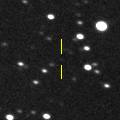
|
It stays 15 mag for a while. In the Northern Hemisphere, it is not observable now, but it will appear in June. It locates somewhat low in the Southern Hemisphere. But it will become high in summer.
Date(TT) R.A. (2000) Decl. Delta r Elong. m1 Best Time(A, h)
Apr. 5 23 39.25 -9 23.2 2.892 2.024 24 14.4 4:15 (273,-12)
Apr. 12 23 54.99 -8 3.5 2.871 2.032 27 14.4 4:04 (272,-11)
|

|
It is expected to brighten up to 13 mag in autumn, and it will be observable in good condition. Now it is 14.9 mag (Feb. 4, Alfons Diepvens). It stays 14 mag for a while. Now it is not observable. It will appear in May.
Date(TT) R.A. (2000) Decl. Delta r Elong. m1 Best Time(A, h)
Apr. 5 0 45.49 8 44.6 4.961 3.963 3 14.5 4:15 (248,-14)
Apr. 12 0 54.24 9 42.8 4.941 3.947 6 14.4 4:04 (249,-12)
|

|
Now it is 14.8 mag (Mar. 10, Alfons Diepvens). It stays 15 mag for a while. It will be getting lower gradually after this, and it will be unobservable in June.
Date(TT) R.A. (2000) Decl. Delta r Elong. m1 Best Time(A, h)
Apr. 5 6 25.04 13 38.8 5.666 5.600 81 14.7 19:50 ( 65, 52)
Apr. 12 6 28.43 14 12.0 5.761 5.590 75 14.8 19:57 ( 73, 46)
|

|
Brightened rapidly. Now it is 14.6 mag (Jan. 31, Thomas Lehmann). Fading slowly. In the Northern Hemisphere, it will be unobservable soon. In the Southern Hemisphere, it is not observable now, but it will appear in May.
Date(TT) R.A. (2000) Decl. Delta r Elong. m1 Best Time(A, h)
Apr. 5 23 59.98 19 18.3 2.739 1.823 19 14.9 4:15 (247, 1)
Apr. 12 0 15.29 18 19.4 2.755 1.835 18 15.0 4:04 (248, 1)
|

|
Now it is 14.8 mag (Mar. 14, Ken-ichi Kadota). Fading slowly. In the Northern Hemisphere, it will be getting lower gradually after this, and it will be unobservable in July. In the Southern Hemisphere, it stays observable in good condition.
Date(TT) R.A. (2000) Decl. Delta r Elong. m1 Best Time(A, h)
Apr. 5 8 37.14 16 17.9 2.083 2.631 112 15.0 19:50 ( 6, 71)
Apr. 12 8 40.97 15 46.8 2.169 2.635 106 15.1 19:57 ( 27, 69)
|

|
Now it is 15.2 mag (Mar. 9, Ken-ichi Kadota). Fading slowly. In the Northern Hemisphere, it will be getting lower gradually after this, and it will be unobservable in July. But it will be observable again in April. In the Southern Hemisphere, it stays observable in good condition.
Date(TT) R.A. (2000) Decl. Delta r Elong. m1 Best Time(A, h)
Apr. 5 13 7.48 -25 22.6 2.482 3.441 160 15.0 0:17 ( 0, 29)
Apr. 12 12 48.07 -23 16.1 2.474 3.446 163 15.0 23:23 ( 0, 32)
|

|
It brightened up to 12.7 mag in last summer (Aug. 7, Thomas Lehmann). Now it is 14.2 mag (Dec. 10, Ken-ichi Kadota). It stays 16 mag for a while. In the Northern Hemisphere, it will be getting higher gradually. It stays extremely low in the Southern Hemisphere.
Date(TT) R.A. (2000) Decl. Delta r Elong. m1 Best Time(A, h)
Apr. 5 22 29.44 17 9.7 3.548 2.820 37 15.0 4:15 (261, 17)
Apr. 12 22 38.00 19 30.2 3.541 2.861 40 15.1 4:04 (260, 20)
|
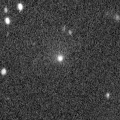
|
Very large comet. It is expected to brighten up to 13 mag in 2031. Now it is 15.1 mag (Mar. 1, Thomas Lehmann). It stays 15 mag for a while. In the Northern Hemisphere, it is not observable now. In the Northern Hemisphere, it is not observable until 2030.
Date(TT) R.A. (2000) Decl. Delta r Elong. m1 Best Time(A, h)
Apr. 5 3 51.11 -66 11.8 15.438 15.275 78 15.3 19:50 ( 26,-26)
Apr. 12 3 55.28 -65 58.3 15.399 15.252 79 15.3 19:57 ( 27,-28)
|

|
First return of a new periodic comet which brightened up to 15 mag in 2010. Now it is 14.3 mag (Mar. 29, Thomas Lehmann). It will fade out rapidly after this. It will be fainter than 18 mag in July. In the Northern Hemisphere, it stays observable in good condition. It stays extremely low in the Southern Hemisphere.
Date(TT) R.A. (2000) Decl. Delta r Elong. m1 Best Time(A, h)
Apr. 5 5 36.80 35 37.2 1.685 1.648 70 15.3 19:50 (105, 52)
Apr. 12 6 0.98 35 57.4 1.741 1.664 68 15.4 19:57 (106, 50)
|

|
Now it is 15.6 mag (Mar. 9, Ken-ichi Kadota). Fading slowly. It locates somewhat low in the Northern Hemisphere. In the Southern Hemisphere, it stays observable in good condition.
Date(TT) R.A. (2000) Decl. Delta r Elong. m1 Best Time(A, h)
Apr. 5 13 15.65 -34 38.0 2.697 3.604 150 15.4 0:24 ( 0, 20)
Apr. 12 13 13.32 -33 51.8 2.685 3.616 154 15.4 23:50 ( 0, 21)
|

|
Now it is 16.1 mag (Mar. 27, Thomas Lehmann). It stays 15 mag for a while. It will be unobservable in May.
Date(TT) R.A. (2000) Decl. Delta r Elong. m1 Best Time(A, h)
Apr. 5 3 38.63 18 27.7 3.256 2.595 41 15.5 19:50 ( 98, 21)
Apr. 12 3 51.12 18 54.2 3.298 2.579 37 15.5 19:57 (102, 17)
|
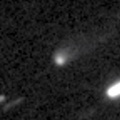
|
Now it is 16.7 mag (Mar. 4, ATLAS Chile). It stays 15 mag for a while. It locates somewhat low in the Northern Hemisphere. In the Southern Hemisphere, it stays observable in good condition.
Date(TT) R.A. (2000) Decl. Delta r Elong. m1 Best Time(A, h)
Apr. 5 18 41.57 -26 11.2 2.674 2.948 95 15.8 4:15 (337, 25)
Apr. 12 18 47.36 -26 27.7 2.578 2.944 101 15.7 4:04 (339, 25)
|

|
Now it is 15.6 mag (Mar. 21, Ken-ichi Kadota). It stays 16 mag for a while. In the Northern Hemisphere, it stays observable in good condition. In the Southern Hemisphere, it will never be observable after this.
Date(TT) R.A. (2000) Decl. Delta r Elong. m1 Best Time(A, h)
Apr. 5 11 16.88 64 23.8 3.969 4.371 107 15.8 22:21 (180, 61)
Apr. 12 11 6.85 65 3.5 4.038 4.362 102 15.9 21:43 (180, 60)
|

|
Now it is 15.9 mag (Feb. 28, Andrew Pearce). It stays 16 mag for a while. In the Northern Hemisphere, it will be unobservable in June. In the Southern Hemisphere, it stays observable in good condition.
Date(TT) R.A. (2000) Decl. Delta r Elong. m1 Best Time(A, h)
Apr. 5 11 38.78 -43 36.9 4.418 5.211 138 15.9 22:42 ( 0, 11)
Apr. 12 11 27.37 -42 12.3 4.428 5.216 138 15.9 22:03 ( 0, 13)
|

|
It is expected to brighten up to 13 mag in early summer in 2026. Now it is 16.8 mag (Jan. 30, Ken-ichi Kadota). Brightening slowly. In the Northern Hemisphere, it will be getting higher gradually. It locates somewhat low in the Southern Hemisphere. But it will become high in summer.
Date(TT) R.A. (2000) Decl. Delta r Elong. m1 Best Time(A, h)
Apr. 5 22 33.72 19 0.4 5.625 4.863 36 16.1 4:15 (259, 18)
Apr. 12 22 34.87 19 29.1 5.525 4.823 41 16.0 4:04 (260, 21)
|

|
Now it is 16.1 mag (Mar. 21, Ken-ichi Kadota). It stays 16 mag for a while. It will be getting lower gradually after this, and it will be unobservable in June.
Date(TT) R.A. (2000) Decl. Delta r Elong. m1 Best Time(A, h)
Apr. 5 6 30.80 3 52.9 3.910 3.923 83 16.1 19:50 ( 53, 46)
Apr. 12 6 32.24 5 38.7 4.014 3.914 77 16.2 19:57 ( 63, 42)
|

|
It brightened up to 13.8 mag in winter (Dec. 30, Thomas Lehmann). Now it is 16.2 mag (Mar. 29, Thomas Lehmann). Fading gradually. It will be fainter than 18 mag in July. In the Northern Hemisphere, it stays observable in good condition. It stays extremely low in the Southern Hemisphere.
Date(TT) R.A. (2000) Decl. Delta r Elong. m1 Best Time(A, h)
Apr. 5 8 17.23 54 24.6 2.605 2.898 96 16.1 19:50 (168, 70)
Apr. 12 8 25.69 52 12.1 2.705 2.932 92 16.3 19:57 (155, 71)
|

|
It will brighten up to 13 mag in 2026. Now it is 16.9 mag (Mar. 5, ATLAS Chile). Brightening slowly. In the Southern Hemisphere, it stays observable in good condition.
Date(TT) R.A. (2000) Decl. Delta r Elong. m1 Best Time(A, h)
Apr. 5 19 46.88 -23 50.5 6.380 6.298 80 16.2 4:15 (321, 20)
Apr. 12 19 47.86 -23 22.1 6.221 6.256 87 16.1 4:04 (324, 22)
|

|
Now it is 16.1 mag (Mar. 9, ATLAS South Africa). It stays 16 mag for a while. It will be unobservable in May in the Northern Hemisphere, or in July in the Southern Hemisphere. But it will be observable again in July in the Southern Hemisphere.
Date(TT) R.A. (2000) Decl. Delta r Elong. m1 Best Time(A, h)
Apr. 5 6 45.38 -18 56.6 6.569 6.636 89 16.3 19:50 ( 33, 29)
Apr. 12 6 47.94 -17 58.7 6.644 6.629 84 16.3 19:57 ( 41, 26)
|

|
It is expected to brighten up to 5 mag in 2026 January. Now it is 16.7 mag (Mar. 19, Ken-ichi Kadota). Brightening gradually. In the Northern Hemisphere, it stays observable in good condition. In the Southern Hemisphere, it will be unobservable in May. But it will be observable again in July.
Date(TT) R.A. (2000) Decl. Delta r Elong. m1 Best Time(A, h)
Apr. 5 18 27.58 49 42.5 4.218 4.335 89 16.5 4:15 (219, 69)
Apr. 12 18 27.77 50 55.1 4.110 4.258 91 16.4 4:04 (211, 70)
|

|
It returned for the first time in 68 years. It brightened up to 6.2 mag in early last summer (July 1, Virgilio Gonano). Now it is 14.6 mag (Feb. 8, Ken-ichi Kadota). Fading gradually. It will be fainter than 18 mag in June. It locates somewhat low in the Northern Hemisphere. In the Southern Hemisphere, it stays observable in good condition.
Date(TT) R.A. (2000) Decl. Delta r Elong. m1 Best Time(A, h)
Apr. 5 18 46.68 -22 17.9 3.494 3.707 94 16.4 4:15 (334, 28)
Apr. 12 18 46.95 -22 50.7 3.449 3.774 101 16.5 4:04 (338, 29)
|
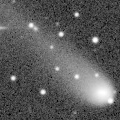
|
Now it is 16.2 mag (Mar. 10, ATLAS Chile). It stays 17 mag for a while. In the Northern Hemisphere, it will be unobservable soon. In the Southern Hemisphere, it will be getting lower gradually. But it will be getting higher again after June.
Date(TT) R.A. (2000) Decl. Delta r Elong. m1 Best Time(A, h)
Apr. 5 5 22.64 -40 46.6 7.292 7.129 76 16.4 19:50 ( 36, 1)
Apr. 12 5 23.21 -39 58.7 7.387 7.174 73 16.5 19:57 ( 41, -3)
|

|
It approached to Earth down to 0.3 a.u. in March. Now it is 16.5 mag (Mar. 14, Ken-ichi Kadota). It will fade out rapidly after this. It will be fainter than 18 mag in May. In the Northern Hemisphere, it stays observable in good condition. In the Southern Hemisphere, it will never be observable after this.
Date(TT) R.A. (2000) Decl. Delta r Elong. m1 Best Time(A, h)
Apr. 5 7 1.52 74 0.5 0.390 1.039 84 16.6 19:50 (171, 49)
Apr. 12 9 39.44 75 51.3 0.428 1.087 89 17.0 20:28 (180, 49)
|
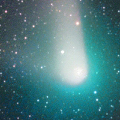
|
It brightened up to 8 mag from 2022 summer to 2023 spring. Now it is 15.4 mag (Mar. 27, Thomas Lehmann). It stays 17 mag for a while. It will be unobservable in May. But it will be observable again in July.
Date(TT) R.A. (2000) Decl. Delta r Elong. m1 Best Time(A, h)
Apr. 5 5 24.72 24 1.7 8.693 8.350 66 16.6 19:50 ( 90, 46)
Apr. 12 5 26.34 24 13.0 8.853 8.403 60 16.7 19:57 ( 95, 39)
|
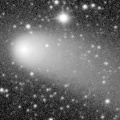
|
It brightened up to 9.6 mag from February to March in 2024 (Feb. 25, 2024, Thomas Lehmann). Now it is 16.7 mag (Mar. 22, Ken-ichi Kadota). It stays 17 mag for a while. In the Northern Hemisphere, it will be getting higher gradually. In the Southern Hemisphere, it is not observable now, but it will appear in May.
Date(TT) R.A. (2000) Decl. Delta r Elong. m1 Best Time(A, h)
Apr. 5 23 3.11 34 48.7 5.868 5.127 38 16.8 4:15 (241, 20)
Apr. 12 23 8.98 35 26.8 5.914 5.192 40 16.9 4:04 (241, 22)
|
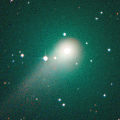
|
It was observed at 9-10 mag for a long time in 2023. Now it is 15.8 mag (Dec. 7, A. Pearce). It stays 17 mag for a while. In the Northern Hemisphere, it will never be observable after this. In the Southern Hemisphere, it stays observable in good condition.
Date(TT) R.A. (2000) Decl. Delta r Elong. m1 Best Time(A, h)
Apr. 5 22 11.94 -62 2.7 7.286 7.092 74 16.8 4:15 (330,-24)
Apr. 12 22 14.89 -62 38.1 7.257 7.145 79 16.8 4:04 (331,-23)
|

|
It brightened up to 15.2 mag in winter (Dec. 30, ATLAS-MLO, Mauna Loa). Now it is 16.6 mag (Mar. 14, Ken-ichi Kadota). Fading gradually. It will be fainter than 18 mag in June. It will be getting lower gradually.
Date(TT) R.A. (2000) Decl. Delta r Elong. m1 Best Time(A, h)
Apr. 5 6 29.81 12 26.5 3.848 3.846 82 16.8 19:50 ( 62, 52)
Apr. 12 6 35.56 12 37.2 3.967 3.868 77 17.0 19:57 ( 69, 47)
|
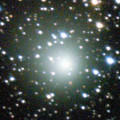
|
It brightened up to 8.3 mag in 2021-2022 winter (Jan. 6, 2022, Toshiyuki Takahashi). Now it is 17.1 mag (Dec. 30, ATLAS South Africa). It stays 17 mag for a while. In the Northern Hemisphere, it will never be observable after this. In the Southern Hemisphere, it stays observable in good condition.
Date(TT) R.A. (2000) Decl. Delta r Elong. m1 Best Time(A, h)
Apr. 5 12 8.63 -60 5.0 9.347 9.956 125 16.9 23:13 ( 0, -5)
Apr. 12 12 4.87 -59 50.6 9.368 9.999 126 16.9 22:41 ( 0, -5)
|

|
It brightened up to 13.1 mag in autumn (Nov. 1, Thomas Lehmann). Now it is 16.6 mag (Mar. 22, Ken-ichi Kadota). Fading gradually. It will be fainter than 18 mag in June. It stays observable in good condition.
Date(TT) R.A. (2000) Decl. Delta r Elong. m1 Best Time(A, h)
Apr. 5 18 3.11 13 31.5 2.425 2.798 101 16.9 4:15 (326, 65)
Apr. 12 17 58.70 13 15.0 2.394 2.864 107 17.0 4:04 (338, 67)
|
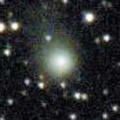
|
It brightened up to 12.1 mag in 2023 spring (May 20, 2023, Jose Guilherme de S. Aguiar). Now it is 17.4 mag (Mar. 7, ATLAS Chile). It stays 17 mag for a while. In the Northern Hemisphere, it will be unobservable in May. In the Southern Hemisphere, it will be getting lower gradually. But it will be getting higher again after June.
Date(TT) R.A. (2000) Decl. Delta r Elong. m1 Best Time(A, h)
Apr. 5 5 36.45 -24 45.9 7.077 6.883 74 17.0 19:50 ( 44, 15)
Apr. 12 5 38.48 -23 46.2 7.199 6.931 70 17.0 19:57 ( 50, 11)
|

|
It returns for the first time in 70 years. It brightened up to 3.7 mag in early April in 2024 (Apr. 6, 2024, Jose Guilherme Aguiar). Now it is 17.2 mag (Feb. 7, Thomas Lehmann). Fading slowly. It will be fainter than 18 mag in June. It stays extremely low in the Northern Hemisphere. In the Southern Hemisphere, it stays observable in good condition.
Date(TT) R.A. (2000) Decl. Delta r Elong. m1 Best Time(A, h)
Apr. 5 17 7.59 -51 32.2 4.149 4.606 111 17.0 4:15 ( 0, 3)
Apr. 12 17 2.01 -51 40.4 4.120 4.673 117 17.1 3:43 ( 0, 3)
|

|
Now it is 17.1 mag (Mar. 10, ATLAS Chile). It stays 17 mag for a while. In the Northern Hemisphere, it will be unobservable in July. In the Southern Hemisphere, it stays observable in good condition.
Date(TT) R.A. (2000) Decl. Delta r Elong. m1 Best Time(A, h)
Apr. 5 11 38.73 -40 56.5 4.558 5.373 141 17.1 22:42 ( 0, 14)
Apr. 12 11 31.43 -39 12.9 4.555 5.368 140 17.1 22:08 ( 0, 16)
|

|
Brightening slowly. It locates somewhat low in the Northern Hemisphere. But it will become high in summer. In the Southern Hemisphere, it stays observable in good condition.
Date(TT) R.A. (2000) Decl. Delta r Elong. m1 Best Time(A, h)
Apr. 5 21 56.08 -21 29.7 3.554 3.040 51 17.2 4:15 (298, 1)
Apr. 12 22 5.82 -20 37.8 3.466 3.026 56 17.1 4:04 (298, 3)
|

|
Now it is 17.2 mag (Mar. 6, ATLAS South Africa). It stays 17 mag for a while. It will be getting lower gradually after this, and it will be unobservable in May in the Northern Hemisphere, or in July in the Southern Hemisphere. But it will be observable again in August in the Southern Hemisphere.
Date(TT) R.A. (2000) Decl. Delta r Elong. m1 Best Time(A, h)
Apr. 5 6 28.86 -6 15.8 4.468 4.475 84 17.1 19:50 ( 45, 38)
Apr. 12 6 32.65 -5 59.1 4.554 4.472 78 17.2 19:57 ( 52, 33)
|

|
Now it is 17.2 mag (Mar. 11, ATLAS South Africa). It stays 18 mag for a while. In the Northern Hemisphere, it will be unobservable in May. In the Southern Hemisphere, it stays observable in good condition.
Date(TT) R.A. (2000) Decl. Delta r Elong. m1 Best Time(A, h)
Apr. 5 7 25.47 -44 21.6 3.468 3.764 99 17.3 19:50 ( 14, 9)
Apr. 12 7 25.59 -41 10.5 3.505 3.752 96 17.3 19:57 ( 22, 10)
|

|
It will brighten up to 9 mag in 2026 spring. Now it is 17.3 mag (Mar. 8, ATLAS-HKO, Haleakala). Brightening slowly. It stays observable in good condition.
Date(TT) R.A. (2000) Decl. Delta r Elong. m1 Best Time(A, h)
Apr. 5 10 25.95 15 46.3 2.448 3.252 137 17.4 21:30 ( 0, 71)
Apr. 12 10 22.13 15 56.5 2.485 3.215 129 17.3 20:59 ( 0, 71)
|

|
Peculiar asteroid moving along a cometary orbit. Now it is 17.5 mag (Feb. 24, Taras Prystavski). It stays 17 mag for a while. In the Northern Hemisphere, it will be unobservable in June.
Date(TT) R.A. (2000) Decl. Delta r Elong. m1 Best Time(A, h)
Apr. 5 4 55.44 -2 50.3 2.265 1.975 60 17.4 19:50 ( 67, 24)
Apr. 12 5 10.15 -1 45.9 2.282 1.946 57 17.4 19:57 ( 72, 21)
|

|
Now it is 17.4 mag (Sept. 20, Taras Prystavski). It stays 17 mag for a while. In the Northern Hemisphere, it will be getting higher gradually. In the Southern Hemisphere, it stays observable in good condition.
Date(TT) R.A. (2000) Decl. Delta r Elong. m1 Best Time(A, h)
Apr. 5 21 6.33 -3 3.0 3.580 3.165 57 17.5 4:15 (291, 23)
Apr. 12 21 13.98 -2 14.3 3.514 3.180 62 17.4 4:04 (292, 25)
|

|
Now it is 17.7 mag (Mar. 4, Erik Bryssinck). It stays 18 mag for a while. In the Northern Hemisphere, it stays observable in good condition. In the Southern Hemisphere, it will never be observable after this.
Date(TT) R.A. (2000) Decl. Delta r Elong. m1 Best Time(A, h)
Apr. 5 7 35.74 61 2.9 5.349 5.434 89 17.7 19:50 (162, 62)
Apr. 12 7 39.73 59 46.7 5.437 5.441 84 17.7 19:57 (154, 61)
|

|
Now it is 17.0 mag (Mar. 7, ATLAS Chile). Fading slowly. It will be fainter than 18 mag soon. It stays extremely low in the Northern Hemisphere. In the Southern Hemisphere, it will be getting lower gradually.
Date(TT) R.A. (2000) Decl. Delta r Elong. m1 Best Time(A, h)
Apr. 5 6 9.08 -25 31.3 4.712 4.681 82 17.7 19:50 ( 37, 19)
Apr. 12 6 8.66 -24 10.7 4.851 4.732 77 17.8 19:57 ( 45, 15)
|
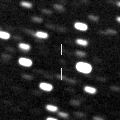
|
Now it is 17.3 mag (Mar. 6, ATLAS Chile). It stays 18 mag for a while. In the Northern Hemisphere, it will never be observable after this. It locates somewhat low in the Southern Hemisphere. But it will become high in summer.
Date(TT) R.A. (2000) Decl. Delta r Elong. m1 Best Time(A, h)
Apr. 5 2 57.11 -48 47.3 5.563 5.150 60 17.7 19:50 ( 46,-24)
Apr. 12 2 59.03 -48 20.3 5.577 5.164 60 17.7 19:57 ( 49,-29)
|

|
Now it is 17.5 mag (Mar. 8, ATLAS-MLO, Mauna Loa). It stays 18 mag for a while. In the Northern Hemisphere, it will be unobservable in May. It locates somewhat low in the Southern Hemisphere. But it will become high in autumn.
Date(TT) R.A. (2000) Decl. Delta r Elong. m1 Best Time(A, h)
Apr. 5 4 30.95 -6 31.1 4.486 3.999 55 17.7 19:50 ( 69, 17)
Apr. 12 4 38.06 -5 52.5 4.556 4.003 51 17.8 19:57 ( 74, 12)
|
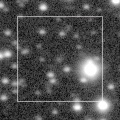
|
Now it is 18.6 mag (Aug. 31, ATLAS Chile). It stays 18 mag for a while. It locates somewhat low in the Northern Hemisphere. But it will become high in summer. In the Southern Hemisphere, it stays observable in good condition.
Date(TT) R.A. (2000) Decl. Delta r Elong. m1 Best Time(A, h)
Apr. 5 17 16.47 -25 56.7 6.306 6.788 114 17.8 4:15 (358, 29)
Apr. 12 17 13.12 -25 25.7 6.181 6.773 122 17.8 3:53 ( 0, 30)
|

|
Now it is 17.5 mag (Mar. 7, ATLAS-MLO, Mauna Loa). Fading slowly. It will be fainter than 18 mag soon. In the Northern Hemisphere, it will be getting lower gradually.
Date(TT) R.A. (2000) Decl. Delta r Elong. m1 Best Time(A, h)
Apr. 5 8 3.38 31 32.3 1.908 2.319 101 17.8 19:50 ( 70, 80)
Apr. 12 8 6.38 28 14.9 1.995 2.320 95 17.9 19:57 ( 71, 73)
|

|
Now it is 18.1 mag (Oct. 11, Erik Bryssinck). It stays 18 mag for a while. In the Northern Hemisphere, it stays observable in good condition. In the Southern Hemisphere, it is not observable now, but it will appear in August.
Date(TT) R.A. (2000) Decl. Delta r Elong. m1 Best Time(A, h)
Apr. 5 19 29.14 55 25.0 5.220 5.148 80 17.8 4:15 (219, 58)
Apr. 12 19 23.86 56 45.5 5.175 5.141 82 17.8 4:04 (213, 60)
|
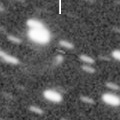
|
Now it is 17.8 mag (Nov. 12, ATLAS-HKO, Haleakala). It stays 18 mag for a while. It stays observable in good condition.
Date(TT) R.A. (2000) Decl. Delta r Elong. m1 Best Time(A, h)
Apr. 5 19 43.97 14 47.4 5.348 5.212 76 17.9 4:15 (290, 50)
Apr. 12 19 42.19 15 3.8 5.275 5.245 82 17.9 4:04 (294, 53)
|

|
It stays bright even after the perihelion passage. Now it is 17.7 mag (Mar. 22, Ken-ichi Kadota). It will fade out rapidly after this. In the Northern Hemisphere, it stays observable in good condition. It locates somewhat low in the Southern Hemisphere.
Date(TT) R.A. (2000) Decl. Delta r Elong. m1 Best Time(A, h)
Apr. 5 14 9.96 53 28.0 1.537 2.199 118 18.1 1:19 (180, 72)
Apr. 12 13 26.56 51 48.8 1.592 2.262 119 18.3 0:09 (180, 73)
|

|
It approached to Sun down to 0.11 a.u. on Mar. 9. It becomes unobseravble temporarily in March. But it will be observable in good condition in April.
Date(TT) R.A. (2000) Decl. Delta r Elong. m1 Best Time(A, h)
Apr. 5 4 0.12 4 10.3 0.285 0.828 45 19.6 19:50 ( 81, 20)
Apr. 12 6 30.24 6 40.2 0.291 0.976 76 18.2 19:57 ( 62, 43)
|

|
It continued rapid brightening even after the perihelion passage. Now it is 17.2 mag (Mar. 3, ATLAS-HKO, Haleakala). It will fade out rapidly after this. In the Northern Hemisphere, it stays observable in good condition. It locates somewhat low in the Southern Hemisphere.
Date(TT) R.A. (2000) Decl. Delta r Elong. m1 Best Time(A, h)
Apr. 5 8 17.18 28 41.6 1.822 2.291 104 18.4 19:50 ( 44, 81)
Apr. 12 8 26.83 28 21.2 1.930 2.325 100 18.6 19:57 ( 62, 77)
|

|
It brightened raidly up to 16.6 mag in winter (Jan. 4, D. Buczynski). Now it is 17.8 mag (Feb. 24, ATLAS-HKO, Haleakala). Fading gradually. In the Northern Hemisphere, it stays observable in good condition. It stays extremely low in the Southern Hemisphere.
Date(TT) R.A. (2000) Decl. Delta r Elong. m1 Best Time(A, h)
Apr. 5 7 31.13 45 0.8 2.252 2.496 92 18.5 19:50 (131, 73)
Apr. 12 7 42.07 44 9.9 2.351 2.519 87 18.6 19:57 (123, 69)
|

|
Bright new periodic comet. It brightened up to 15.9 mag (Feb. 7, P. Sicoli). It seems to have brightened temporarily in outburst. Now it is 17.3 mag (Mar. 8, ATLAS Chile). It will fade out rapidly after this. It stays observable in good condition.
Date(TT) R.A. (2000) Decl. Delta r Elong. m1 Best Time(A, h)
Apr. 5 14 18.00 -18 9.2 1.821 2.768 156 18.6 1:26 ( 0, 37)
Apr. 12 14 13.54 -18 11.9 1.796 2.773 164 19.0 0:54 ( 0, 37)
|

|
It approached to Sun down to 0.1 a.u. on Jan. 29, to Earth down to 0.1 a.u. in early March, and it brightened up to 14.4 mag (Mar. 6, Alfons Diepvens). Fading rapidly. In the Northern Hemisphere, it stays observable in good condition.
Date(TT) R.A. (2000) Decl. Delta r Elong. m1 Best Time(A, h)
Apr. 5 9 56.03 29 9.7 0.755 1.557 124 19.1 21:01 ( 0, 84)
Apr. 12 9 57.93 27 7.3 0.925 1.663 119 19.7 20:35 ( 0, 82)
|
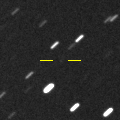
|
It became much fainter than predicted after the perihelion passage. Now it is 20.0 mag (Mar. 12, Taras Prystavski). It stays 20 mag for a while. It stays observable in good condition.
Date(TT) R.A. (2000) Decl. Delta r Elong. m1 Best Time(A, h)
Apr. 5 19 39.65 -12 9.5 2.045 2.124 80 19.5 4:15 (316, 31)
Apr. 12 19 50.28 -11 13.5 1.985 2.139 84 19.5 4:04 (316, 32)
|

|
It approached to Sun down to 0.07 a.u. on Mar. 3. In the Southern Hemisphere, it is appearing in the morning sky. In the Northern Hemisphere, it will never be observable after this.
Date(TT) R.A. (2000) Decl. Delta r Elong. m1 Best Time(A, h)
Apr. 5 21 42.78 -37 33.5 0.955 1.015 62 20.0 4:15 (312, -7)
Apr. 12 21 32.65 -41 6.0 0.962 1.158 72 20.6 4:04 (318, -5)
|

|
It approached to Earth down to 0.2 a.u. in mid February, and it was observed at 20.4 mag (Feb. 8, Steward Observatory, Mt. Lemmon Station). It approached to Sun down to 0.04 a.u. on Mar. 14. It is appearing in the evening low sky.
Date(TT) R.A. (2000) Decl. Delta r Elong. m1 Best Time(A, h)
Apr. 5 3 34.85 21 5.7 1.181 0.789 41 22.9 19:50 (101, 23)
Apr. 12 4 20.85 23 15.8 1.332 0.950 45 23.3 19:57 (102, 26)
|
|
![]()
 C/2024 G3 ( ATLAS )
C/2024 G3 ( ATLAS ) C/2023 A3 ( Tsuchinshan-ATLAS )
C/2023 A3 ( Tsuchinshan-ATLAS ) 29P/Schwassmann-Wachmann 1
29P/Schwassmann-Wachmann 1 C/2021 G2 ( ATLAS )
C/2021 G2 ( ATLAS ) (3200) Phaethon
(3200) Phaethon 217P/LINEAR
217P/LINEAR 49P/Arend-Rigaux
49P/Arend-Rigaux C/2022 E2 ( ATLAS )
C/2022 E2 ( ATLAS ) 48P/Johnson
48P/Johnson C/2022 N2 ( PanSTARRS )
C/2022 N2 ( PanSTARRS ) C/2022 QE78 ( ATLAS )
C/2022 QE78 ( ATLAS ) C/2024 J2 ( Wierzchos )
C/2024 J2 ( Wierzchos ) P/2023 S1 ( PanSTARRS )
P/2023 S1 ( PanSTARRS ) C/2024 L5 ( ATLAS )
C/2024 L5 ( ATLAS ) C/2023 C2 ( ATLAS )
C/2023 C2 ( ATLAS ) C/2014 UN271 ( Bernardinelli-Bernstein )
C/2014 UN271 ( Bernardinelli-Bernstein ) 496P/2024 S3 ( Hill )
496P/2024 S3 ( Hill ) C/2023 T3 ( Fuls )
C/2023 T3 ( Fuls ) 43P/Wolf-Harrington
43P/Wolf-Harrington 65P/Gunn
65P/Gunn C/2023 H5 ( Lemmon )
C/2023 H5 ( Lemmon ) C/2023 F3 ( ATLAS )
C/2023 F3 ( ATLAS ) C/2023 R1 ( PanSTARRS )
C/2023 R1 ( PanSTARRS ) C/2024 A1 ( ATLAS )
C/2024 A1 ( ATLAS ) C/2023 Q1 ( PanSTARRS )
C/2023 Q1 ( PanSTARRS ) C/2024 J3 ( ATLAS )
C/2024 J3 ( ATLAS ) C/2022 R6 ( PanSTARRS )
C/2022 R6 ( PanSTARRS ) C/2024 E1 ( Wierzchos )
C/2024 E1 ( Wierzchos ) 13P/Olbers
13P/Olbers C/2019 U5 ( PanSTARRS )
C/2019 U5 ( PanSTARRS ) 499P/2025 A5 ( Catalina )
499P/2025 A5 ( Catalina ) C/2017 K2 ( PanSTARRS )
C/2017 K2 ( PanSTARRS ) C/2021 S3 ( PanSTARRS )
C/2021 S3 ( PanSTARRS ) C/2020 V2 ( ZTF )
C/2020 V2 ( ZTF ) 472P/2023 RL75 ( NEAT-LINEAR )
472P/2023 RL75 ( NEAT-LINEAR ) C/2019 L3 ( ATLAS )
C/2019 L3 ( ATLAS ) C/2024 B1 ( Lemmon )
C/2024 B1 ( Lemmon ) C/2020 K1 ( PanSTARRS )
C/2020 K1 ( PanSTARRS ) 12P/Pons-Brooks
12P/Pons-Brooks C/2024 G2 ( ATLAS )
C/2024 G2 ( ATLAS ) 47P/Ashbrook-Jackson
47P/Ashbrook-Jackson 195P/Hill
195P/Hill C/2024 X2 ( ATLAS )
C/2024 X2 ( ATLAS ) 88P/Howell
88P/Howell (308607) 2005 WY3
(308607) 2005 WY3 362P/(457175) 2008 GO98
362P/(457175) 2008 GO98 C/2024 N4 ( Sarneczky )
C/2024 N4 ( Sarneczky ) C/2022 L2 ( ATLAS )
C/2022 L2 ( ATLAS ) C/2023 U1 ( Fuls )
C/2023 U1 ( Fuls ) 242P/Spahr
242P/Spahr C/2024 G6 ( ATLAS )
C/2024 G6 ( ATLAS ) C/2024 V1 ( Borisov )
C/2024 V1 ( Borisov ) C/2023 V1 ( Lemmon )
C/2023 V1 ( Lemmon ) C/2022 U1 ( Leonard )
C/2022 U1 ( Leonard ) C/2024 PN7 ( PanSTARRS )
C/2024 PN7 ( PanSTARRS ) (431760) 2008 HE
(431760) 2008 HE P/2024 T2 ( Rankin )
P/2024 T2 ( Rankin ) 33P/Daniel
33P/Daniel P/2025 C1 ( ATLAS )
P/2025 C1 ( ATLAS ) (465402) 2008 HW1
(465402) 2008 HW1 105P/Singer Brewster
105P/Singer Brewster P/2008 Y12 = P/2014 K3 ( SOHO )
P/2008 Y12 = P/2014 K3 ( SOHO ) 323P/SOHO
323P/SOHO![]()

























































